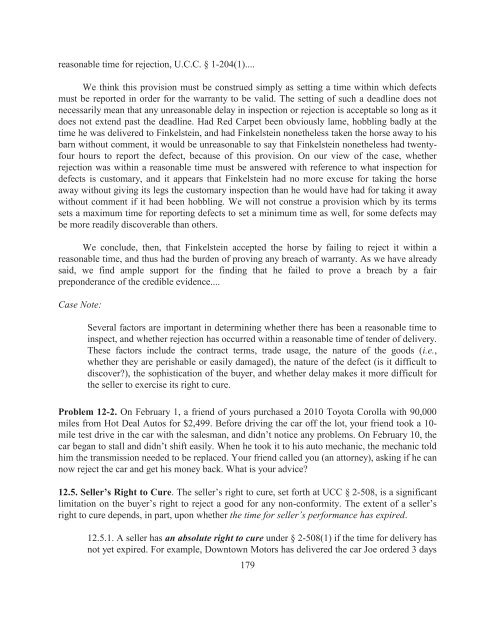Sales and Leases - A Problem-based Approach, 2016a
Sales and Leases - A Problem-based Approach, 2016a
Sales and Leases - A Problem-based Approach, 2016a
You also want an ePaper? Increase the reach of your titles
YUMPU automatically turns print PDFs into web optimized ePapers that Google loves.
easonable time for rejection, U.C.C. § 1-204(1)....<br />
We think this provision must be construed simply as setting a time within which defects<br />
must be reported in order for the warranty to be valid. The setting of such a deadline does not<br />
necessarily mean that any unreasonable delay in inspection or rejection is acceptable so long as it<br />
does not extend past the deadline. Had Red Carpet been obviously lame, hobbling badly at the<br />
time he was delivered to Finkelstein, <strong>and</strong> had Finkelstein nonetheless taken the horse away to his<br />
barn without comment, it would be unreasonable to say that Finkelstein nonetheless had twentyfour<br />
hours to report the defect, because of this provision. On our view of the case, whether<br />
rejection was within a reasonable time must be answered with reference to what inspection for<br />
defects is customary, <strong>and</strong> it appears that Finkelstein had no more excuse for taking the horse<br />
away without giving its legs the customary inspection than he would have had for taking it away<br />
without comment if it had been hobbling. We will not construe a provision which by its terms<br />
sets a maximum time for reporting defects to set a minimum time as well, for some defects may<br />
be more readily discoverable than others.<br />
We conclude, then, that Finkelstein accepted the horse by failing to reject it within a<br />
reasonable time, <strong>and</strong> thus had the burden of proving any breach of warranty. As we have already<br />
said, we find ample support for the finding that he failed to prove a breach by a fair<br />
preponderance of the credible evidence....<br />
Case Note:<br />
Several factors are important in determining whether there has been a reasonable time to<br />
inspect, <strong>and</strong> whether rejection has occurred within a reasonable time of tender of delivery.<br />
These factors include the contract terms, trade usage, the nature of the goods (i.e.,<br />
whether they are perishable or easily damaged), the nature of the defect (is it difficult to<br />
discover?), the sophistication of the buyer, <strong>and</strong> whether delay makes it more difficult for<br />
the seller to exercise its right to cure.<br />
<strong>Problem</strong> 12-2. On February 1, a friend of yours purchased a 2010 Toyota Corolla with 90,000<br />
miles from Hot Deal Autos for $2,499. Before driving the car off the lot, your friend took a 10-<br />
mile test drive in the car with the salesman, <strong>and</strong> didn’t notice any problems. On February 10, the<br />
car began to stall <strong>and</strong> didn’t shift easily. When he took it to his auto mechanic, the mechanic told<br />
him the transmission needed to be replaced. Your friend called you (an attorney), asking if he can<br />
now reject the car <strong>and</strong> get his money back. What is your advice?<br />
12.5. Seller’s Right to Cure. The seller’s right to cure, set forth at UCC § 2-508, is a significant<br />
limitation on the buyer’s right to reject a good for any non-conformity. The extent of a seller’s<br />
right to cure depends, in part, upon whether the time for seller’s performance has expired.<br />
12.5.1. A seller has an absolute right to cure under § 2-508(1) if the time for delivery has<br />
not yet expired. For example, Downtown Motors has delivered the car Joe ordered 3 days<br />
179


















